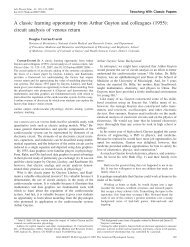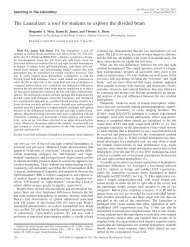construction of a model demonstrating neural pathways and reflex arcs
construction of a model demonstrating neural pathways and reflex arcs
construction of a model demonstrating neural pathways and reflex arcs
Create successful ePaper yourself
Turn your PDF publications into a flip-book with our unique Google optimized e-Paper software.
I N N 0 V A T I 0 N S A N D I D E A S<br />
finger<br />
\<br />
\ sensory receptor<br />
pain stimulus<br />
, cell body <strong>of</strong> sensory neuron<br />
FIG. 2.<br />
Example <strong>of</strong> a sensory neuron with its structures labeled. Tack is providing<br />
stimulus. This sensory neuron is receiving input from a sensory receptor in the<br />
finger. Sensory neuron is unique in that it only has an axon by which it<br />
transmits information. Information carried by this neuron continues in the<br />
body by way <strong>of</strong> a tract to reach the brain.<br />
functions. Efferent neurons cause an appropriate re-<br />
sponse to the sensory information received. An ex-<br />
ample <strong>of</strong> a motor neuron is shown in Fig. 3.<br />
Association neurons are also called interneurons.<br />
Interneurons are found between afferent (incoming<br />
sensory information) <strong>and</strong> efferent (outgoing motor<br />
information) neurons. Interneurons serve many func-<br />
tions <strong>and</strong> can have many connections. Interneurons<br />
are involved in information processing <strong>and</strong> are found<br />
only in the CNS. An example <strong>of</strong> an interneuron is<br />
shown in Fig. 4.<br />
dend rites <strong>of</strong><br />
mot0 r neuron<br />
cell body <strong>of</strong> motor neuron<br />
motor neuron<br />
The site <strong>of</strong> transmission between two neurons is<br />
called a synapse. A synapse is an anatomic structure<br />
that involves two neurons <strong>and</strong> the space between<br />
them. The synaptic space is very small, <strong>and</strong> it can be<br />
seen best with an electron microscope. A synapse is<br />
different from synaptic transmission. Synaptic trans-<br />
mission is an event that occurs at the synapse; the<br />
synapse itself is a structure. A schematic <strong>of</strong> a synapse<br />
is shown in Fig. 5.<br />
1) -+Name the three types <strong>of</strong> neurons. Are they<br />
afferent, efferent, or neither?<br />
axon hillock <strong>of</strong> motor neuron<br />
Nodes <strong>of</strong> Ranvier<br />
axon <strong>of</strong> motor<br />
\<br />
target muscle<br />
FIG. 3.<br />
Motor neuron with structural components labeled. Motor neuron is<br />
shown with its target muscle.<br />
VOLUME 16 : NUMBER 1 - ADVANCES IN PHYSIOLOGY EDUCATION - DECEMBER 1996<br />
s17









